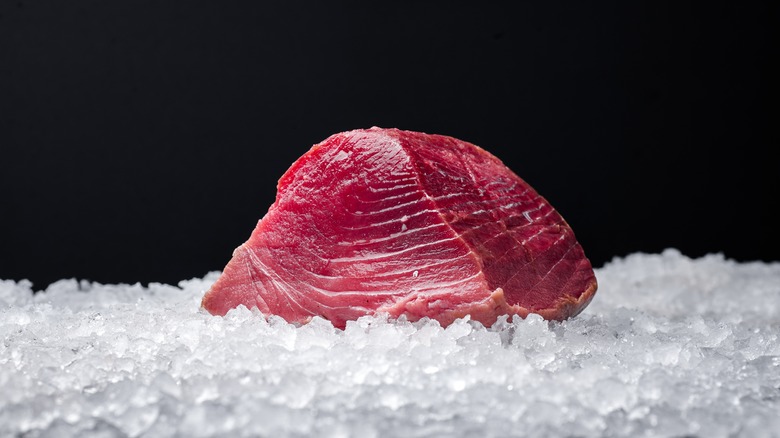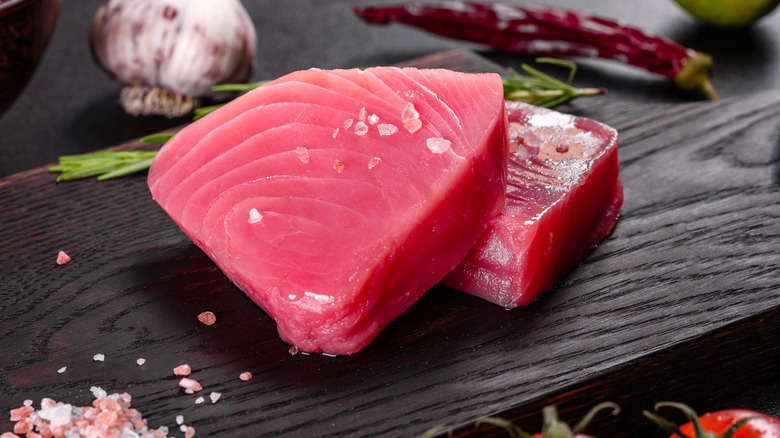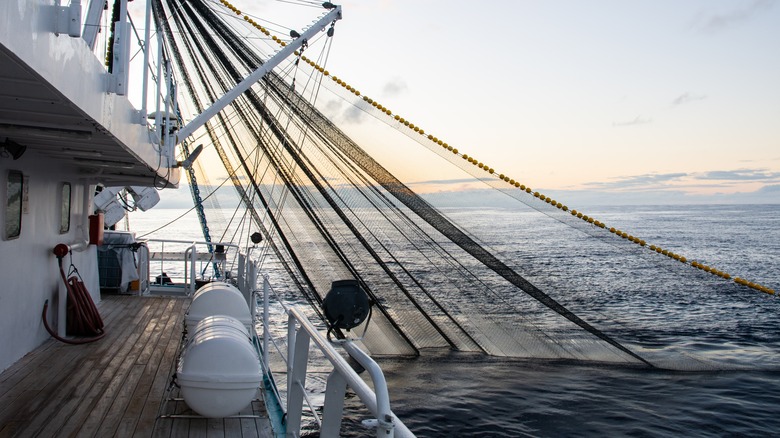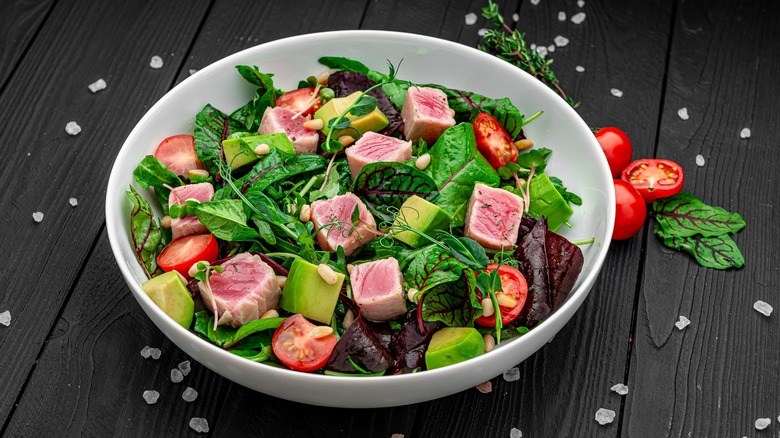Most Of The World's Tuna Comes From This Country
Some people love red meat, others enjoy the fishier side of life, while a handful of individuals reject the concept of animal-based protein altogether. Yet, regardless of personal tastes, World Wildlife lists seafood as the largest traded food commodity in the world with over 3 billion people utilizing it as their main source of protein, making it an extremely profitable and competitive market. It seems like seafood is always in demand, and the call for fish is expected to double within the next twenty years, and meat and dairy will decline in popularity as a result (via New Scientist).
As it is right now, Tucko claims that a few of the most widely consumed fish in the world are salmon, cod, tilapia, sardines, catfish, and it just so happens that the number one consumed fish in the world is tuna. Tuna can be found fresh or canned at markets today thanks to seafaring countries dominating ocean fishing today, the ring leader of which is Indonesia.
Tuna in Indonesia
Indonesia is made up of over 17,000 islands and is sandwiched between the Indian and Pacific Oceans as well as the China Sea (via Shanti Travel). That's a lot of water to pull resources from! And with the additional benefit of being located on the equator, fish flock to the waters of the Indonesian archipelago. In the last decade, Taipei Times reports that Indonesia has cracked down on illegal poaching and revitalizing pole-and-line fishing practices which have been traditional on the islands for decades. The expansion of the tuna fishing industry has gone on to provide jobs and food for the country and has successfully made Indonesia the largest source of tuna in the world (via Tridge).
In 2016, The Asean Post claimed that Indonesia produced 17.9% of the world's tuna while the Philippines harvested 6.1%. In 2021, Indonesia exported $325.4 million worth of tuna. As for the kinds of tuna Indonesia is collecting, the Research Institute for Marine Fisheries states that skipjack tuna makes up 62.7% of the total collected, yellowfin tuna is a distant second at 24.5%, and then bullet tuna is 12.8% of the haul. In addition to being the world's largest producer, Indonesian Tuna says that the fishing industry is engaged in a Fishery Improvement Plan and is aiming for MSC certification (Marine Stewardship Council) which is a great way to protect marine resources.
The history of tuna
Tuna is a lovely fish because, well, it isn't overpoweringly fishy. Even when eaten raw in sushi, the tuna has a light meaty flavor that makes you want to tuck in and enjoy it. That is one of the reasons tuna has been a staple culinary item in Japanese, Pacific Island, and Mediterranean cruises for centuries. According to Live-in Home Care, tuna has been fished off the Mediterranean coast for over 2,000 years and Greek philosophers and authors alike have noted the benefits of regular tuna consumption, but it is widely believed that tuna has been consumed since the beginning of the Stone Age.
Tuna is still harvested in the Mediterranean for its meat and milt, but the largest amount of this "Chicken of the Sea" is actually sourced from the Pacific Ocean. Ocean Find Your Blue says that bluefin tuna spawn in the sea of Japan and then tend to migrate all over the Pacific, traveling to the coast of California and all the way down to New Zealand. This explains tuna's widespread popularity, but it's also due to its delectable flavor, high protein content, and amino acid levels, per Komira. Because of this high demand, tuna can get expensive. But, if you love it, it's worth the cost.
Nutrition of tuna
Regardless of how good tuna might taste cubed in tacos, smushed between our sandwiches, or dipped into a bowl of soy sauce, it's important to ask ourselves if it's nutritious. Luckily, Healthline knows the answer. In regard to canned tuna, if the fish is stored in oil it will have higher calories and fat than if it is stored in water, but tuna is already relatively low in fat and canned tuna is still a wonderful source of protein, vitamins, minerals, and omega-3 fatty acids. The same applies to fresh tuna, according to the SF Gate. Fresh tuna has an abundance of lean protein and has the same nutritional values as the canned kind, and if you add more tuna to your diet it is believed to help lower your risk of chronic health conditions.
So, how can you incorporate more tuna into your everyday life? Holland & Barrett says that the possibilities are endless! If you're a sandwich lover, whip up a classic tuna melt on some delicious panini bread, and you have yourself a filling lunch. You can also add tuna to pasta or casserole dishes and salads in the place of chicken, or use it as a garnish for your baked potatoes. And lest we forget, the Japanese-inspired sashimi which is quality raw tuna dipped in tamari sauce. There are plenty of ways to add a little of this healthy fish to your diet.



